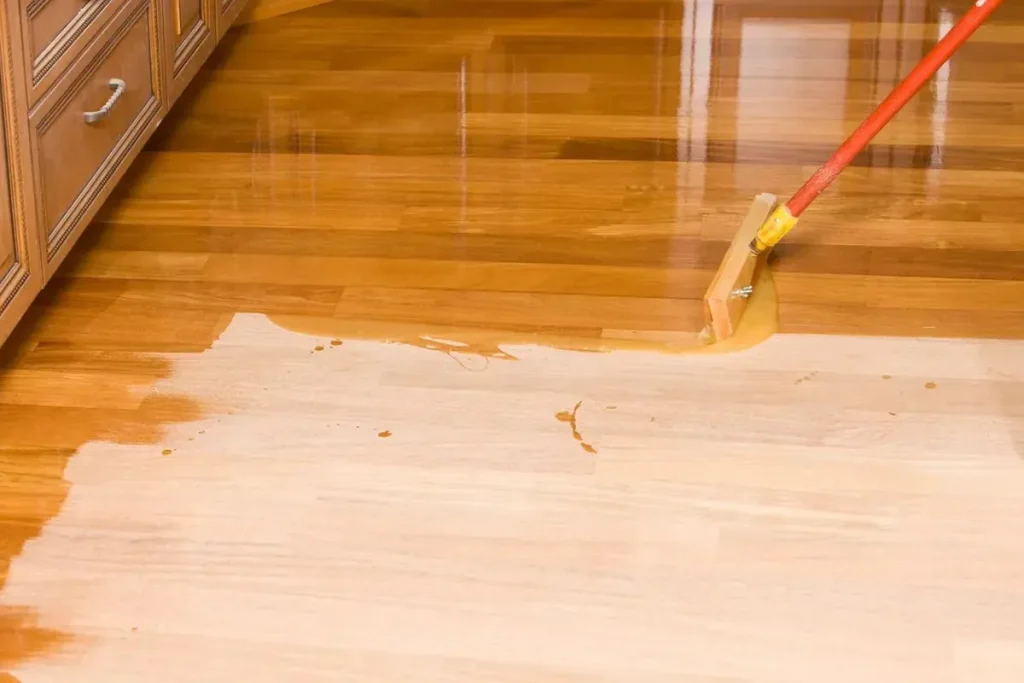If you’ve ever lived through a floor sanding job, you know what dust can do. It gets everywhere — vents, closets, even inside drawers you never opened. You wipe for weeks, and somehow there’s still a haze on your TV.
That’s what “traditional sanding” leaves behind. Which is why dust containment isn’t a luxury. It’s standard procedure if you want a clean, professional refinishing job — and a house you can actually live in when we’re done.
“Dustless” Isn’t Real — But Containment Is
You’ll see a lot of ads around Denver claiming “100% dust-free sanding.” That’s marketing talk. No system on earth can trap every speck of fine dust. What professionals use is dust containment, which captures 90–97% of it before it ever drifts through the house.
Here’s how it works:
- Our sanders connect directly to high-powered vacuums through sealed hoses.
- Each machine pulls dust into a separate collection system — not a paper bag.
- We seal vents, doorways, and returns before sanding starts.
- After each grit stage, we vacuum every inch before moving on.
The result isn’t spotless like a lab, but it’s clean enough that you can walk the job mid-process without coughing or wiping your counters afterward.
That’s the difference between a professional hardwood floor refinishing Denver homeowners actually appreciate — and one they regret hiring.
Why Dust Matters More Than You Think
Dust isn’t just messy. It’s a real problem if you care about how your floors turn out.
- Finish contamination. Fine particles settle back onto wet coats, leaving bumps and haze. You can’t fix that with another coat — you have to re-sand.
- Air quality. Sanding old finishes kicks up fine particulates that hang in the air for hours. Without containment, your HVAC pulls that through the whole house.
- Static and allergy issues. Colorado’s dry air builds static, and fine dust clings to everything — fabrics, electronics, lungs.
Containment means the only thing you notice after refinishing is how good your floor looks, not how long you’ll be cleaning.
How It Affects the Final Look
Clean air equals clean finish. That’s not marketing — it’s physics.
When the space is clear of dust, the polyurethane (or waterborne finish) cures evenly. You get smooth sheen, better adhesion, and fewer micro-bubbles.
We’ve refinished plenty of Arvada and Westminster homes that had to be redone because someone skipped this step. The floors looked cloudy or gritty within a week. The owners thought they had a bad product; what they really had was a dusty worksite.
The Right Equipment Matters
Not all “dustless” systems are equal. Some crews rent small vacs that can’t keep up. Others use outdated cloth bags that leak like crazy.
Our setup:
- Industrial-grade vacuums mounted outside or in a separate area.
- HEPA filtration rated for fine wood dust.
- Hose systems sealed tight at every joint.
- Machines emptied offsite — not dumped into your trash can.
It’s not the cheapest way to refinish floors, but it’s the only way to do it without coating your house in powder.
Why Denver Homes Need It Even More
Our region makes dust worse.
- Low humidity means particles stay airborne longer.
- Forced-air heat moves air fast, carrying dust into ducts and rooms you thought were sealed.
- Older homes with floor registers near the baseboards act like vacuum exhausts for debris.
That’s why containment isn’t optional here. It’s protection for your home and the finish you’re paying for.
What Homeowners Can Expect During Refinishing
If you’ve never had floors done this way, here’s what to expect:
- Setup day: We move furniture or help you plan what stays. Vents get taped, returns get covered.
- Sanding: We connect each machine to vacs and sand the floor in multiple passes (coarse → medium → fine).
- Stain and finish: Once everything’s smooth, we clean the surface again before applying stain and topcoats.
- Dry and cure: Most Denver jobs take 3–5 days start to finish, depending on humidity and product.
- Cleanup: We vacuum the site and check edges, corners, and transitions. You get a walkthrough before we pack up.
You’ll still see a little dust — nothing’s perfect — but you won’t feel like you’re camping inside a construction zone.
What It Costs (and Why It’s Worth It)
Dust containment adds some cost up front — usually around $0.50–$1 per square foot compared to a basic refinish. But it saves money in cleanup, repainting, and redoing the work if dust gets trapped in the finish.
Think of it as insurance for your floors. You’re paying to refinish once, not twice.
Real Example: Before and After
A client in Littleton had their 1,200 sq. ft. oak floors sanded by a “budget” crew the year before we met them. The finish was rough and cloudy, and there was still dust on the blinds nine months later.
We came in, contained the site, re-sanded everything, and used a waterborne satin finish. They stayed in the house the whole time, no cleanup marathon afterward. Same floor, totally different experience.
Why We Don’t Skip It
Dust containment isn’t just equipment — it’s mindset. We treat every job like it’s happening in our own home. If we wouldn’t want to breathe it or clean it, neither should you.
We take the time to seal, clean, and protect before and after. That’s what makes the difference between a “good enough” floor and one that still looks right ten years later.
The Bottom Line
When you’re getting quotes for hardwood floor refinishing in Denver, ask every contractor one simple question:
“How are you handling dust containment?”
If they hesitate or say, “We’ve got bags on our sanders,” move on. That’s not containment — that’s cleanup for you later.
A clean refinish isn’t about fancy equipment or buzzwords. It’s about respect for your home and doing the job right from start to finish.

